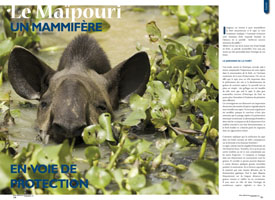Imagine for a moment what the Amazonian forest would look like if the tapir was completely eradicated. How would this immense tropical rainforest evolve were this peaceful herbivore – and one the public often knows little about – no longer to exist there?
Even though you do not often come across them as you’re walking through the forest, this placid mammal nevertheless plays a key role in the ecology of forests in French Guiana.
The forest garden
A study carried out in Central America which totally excluded tapirs from the observation zone throws light on how this species plays an important role in shaping the forest. It is known that the tapir plays an important role packing down the soil and spreading the seeds of some species. The process used was simple: fences were set up which only kept the tapir out, the largest land mammal in South America.
These investigations showed that there was a sharp drop in the number of plant species in the zone from which the tapirs were excluded. The structure of the zone was altered since the undergrowth was no longer maintained by the tapir repeatedly passing through it and trampling the soil. The dynamics of the forest underwent consequences due to the disappearance of an essential link in its proper functioning, and the forest under study soon bore the signs of this, right down to the way it was structured.
How can we account for the fact that the drop in the number of tapirs in our forests results in such consequences for their diversity and structure?
Like all Amazonian ungulates, the tapir is very keen on fruits. However it can only get at those which have fallen on the ground and have not been consumed by other fruit eaters. It makes up for this lack in its diet by eating all the seeds. Whilst deer and peccaries can disperse a few seeds over a short distance by spitting them out during mastication, they crush most of them which are then destroyed during gastric fermentation. The tapir is the only animal to frequently disperse viable intact seeds over long distances in its excrement. It therefore plays a key role in the ecology of many plants species and in the forest by helping seeds to survive and regenerate, and by reducing the probability of their being attacked by insects in particular. Thanks to its 200kg bulk it also alters the soil by repeatedly trampling and turning it over in certain zones.
Dropping numbers
Although it is found spread over a wide area (in ten countries in South America) it is a species with a relatively low population density (between 0 and 1 per square kilometre), and this is on the decrease. The comparative scarcity of this herbivore is partly due to certain of its natural characteristics: on the one hand it does not reproduce much, and on the other it requires a large territory to survive. The natural fragility of its population numbers is worsened by strong pressure from people. Man is the tapir’s number one predator, and too many are eliminated by hunting. But it is especially the progressive disappearance of its habitat, the tropical forest, which poses a threat to the species across South America as a whole.
The tapir is considered as an endangered species in most of the countries of South America, and is listed in Appendix II of the CITES Convention. The Convention on International Trade in Endangered Species of Fauna and Flora, or Washington Convention, establishes rules for cross-border trade in several tens of thousands of species of animals and plants, whether they are alive or dead, as well as any part composing them and derived products.
Due to its over-exploitation and habitat loss, it is also listed as “vulnerable” on the World Conservation Union red list (the most complete list in the world of the global conservation status of animal and plant species).
Studies carried out in Amazonia emphasise that in many places it has disappeared and that it is strongly affected by hunting due to the “non-sustainability” of current practices for this species. However, many countries with tapir populations have understood the threat facing it, and everywhere it now enjoys protected status or else hunting it is subject to strict regulations. Surinam has forbidden tapir hunting for part of the year, Brazil forbids trade in it, Bolivia fully protects it, etc. In French Guiana the tapir has just been removed from the list of tradable species (in July 2007), after many years of commercial exploitation and the removal of more than the maximum recommended numbers.
Large range of stUDies and methods already in place in French Guiana
On the strength of the observed drop in the number of tapirs in French Guiana, scientists have introduced several protocols to monitor this problem more precisely and see how it changes over time. To this end the Kwata Association is carrying out a study based on counting tracks left by tapirs which are often to be seen near creeks. It is necessary to carry out these counts over several years given the lack of any local statistical points of reference. Another study carried out by the ONCFS is based on photo-trapping populations in forests (see inset).
All these various inventories underline the decline in tapir populations in French Guiana and the very low population density in hunting zones.
In addition to classical field studies new techniques have enabled scientists to build up a vast panel of data that had hitherto not been available. Genetics is an additional tool helping to conserve the species by tackling problems that cannot be addressed using classical ecological approaches. It provides information about the status and dynamics of populations, trends (decline or increase), the way genes flow from one population to another, and their “isolation”.
The first study of this type carried out for tapirs was conducted by Benoît De Thoisy, from the Kwata Association. The results were presented during the 7th International Conference for Wildlife Management in Amazonia, held in Brazil.
Genetic study of tapir populations was conducted using skin samples recovered from hunters. The results showed that there is a relatively high degree of genetic diversity amongst tapirs in French Guiana, and that the populations are genetically “homogenous” from one end of territory to the other. The genetic diversity was in particular greater than that recently observed amongst the highly endangered tapir populations of Central America, which now only live in fragments of the forests. This data suggests that the French Guianese tapir is in comparatively good “health”. Nevertheless, these results need to be set against the existence of a “strangling effect” with the rapid loss of a large number of animals over recent years, which has had an observable effect on the population’s genetic profile.
It is harder to ascertain the impact of hunting on species numbers. Professionals in hunting management assert that tapir hunting will only be sustainable if no more than 3% of the density (biomass) of the population is removed each year in the zone under pressure from hunting. A worldwide study of this carried out by a group of scientific partners (GIS Silvolab) with a certain number of hunters shows that the numbers hunted unfortunately exceed the recommended limits. That is why the extinction of the species has been observed in certain localities, something which could spread rapidly. Hunters are obliged to go further and further into the forests of the interior, since those on the coast no longer “produce” enough.
But basic knowledge still lacking
Recent changes to the law in French Guiana represent marked progress, but many parameters relating to the species are still not known and should be monitored more closely. Much of the basic knowledge about the biology of this species comes from studies carried out in Amazonian countries with different environmental conditions. Whilst we are beginning to acquire enough knowledge about the tapir to now be able to put in place emergency management measures in French Guiana, there is still a need to extend our understanding of the species’ biology and ecology by studying it in its local natural habitat. This would entail regularly evaluating the state of populations in French Guiana, even though it is always hard to estimate the numbers of species with naturally low population densities.
What more could be done for the tapir?
Human pressure on tapir populations needs to be significantly reduced if we are to ensure a lasting future for this endangered species. What is needed across South America to ensure the distribution of the tapir population is to act against deforestation, the main threat to the species. Reducing alterations and disturbances to its ecosystem is the most important point for conserving this species, as it is for many others also affected by this alarming problem.
The situation in French Guiana is one of relatively healthy in comparison to its South American neighbours. However, the management of the forest habitat needs to be reinforced. There are an increasing number of trails opening up forest areas which until then had been protected by the absence of any cleared pathways. Increased levels of hunting may be observed in zones that are easier to get to what with the presence of roads, trails, and pathways. Improved management of the forest habitat makes it possible to control the creation of these openings and access to them. What is more, protecting non-hunting zones reduces the pressure upon tapir populations. Protected areas in French Guiana can play a major role by acting as refuges sheltering tapir “stocks” that can subsequently recolonise zones from which they have been hunted.
It would be possible to set up sustainable management of the species via the introduction of complementary measures, including some which are already in place in nearby countries and which are starting to be discussed in consultation meetings between authorities and hunters in French Guiana. This would make it possible to establish a hunting “quota” for tapirs, thus reducing the number of individuals removed from the forest each year on the basis of limits recommended by scientists. Equally tapir hunting could become seasonal, as it is in Surinam. The populations would be left “to rest” for several months of the year, during which time they would not be subject to pressure from hunting, thus allowing them to rebuild themselves.
The most effective means of guaranteeing the future of the species in French Guiana would be a blanket ban on tapir hunting, as is already the case for certain particularly endangered species. Such a decision could be accompanied by certain allowances taking into account the particularities of tapir hunting. For instance a special right to hunt them could be accorded to forest populations who are genuinely dependent on this source of protein, and for whom the tapir has an important symbolic value.
For individuals, choosing not to eat tapir meat is already a step forward in the protection of this forest species.




 English
English Français
Français  Português
Português 








 Télécharger l'article en PDF est réservé aux abonnés Web !
Télécharger l'article en PDF est réservé aux abonnés Web ! 
 Pas de réaction
Pas de réaction Comment!
Comment!


 Voyages avec Tooy. Histoire, mémoire, imaginaire des Amériques noires : Editions Vents d’ailleurs, 2010
Voyages avec Tooy. Histoire, mémoire, imaginaire des Amériques noires : Editions Vents d’ailleurs, 2010
 Guyane. Produits du terroir et recettes traditionnelles. L’inventaire du patrimoine culinaire de la France : Editions Albin Michel, 1999
Guyane. Produits du terroir et recettes traditionnelles. L’inventaire du patrimoine culinaire de la France : Editions Albin Michel, 1999
 Alunawalé, un voyage à travers les milieux naturels de Guyane : Office National des Forêts, 2009
Alunawalé, un voyage à travers les milieux naturels de Guyane : Office National des Forêts, 2009
 Augusta Curiel, Fotografe in Suiriname 1904 – 1937 : Libri Misei Surinamensis, 2007
Augusta Curiel, Fotografe in Suiriname 1904 – 1937 : Libri Misei Surinamensis, 2007


